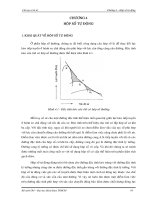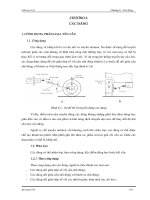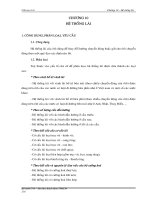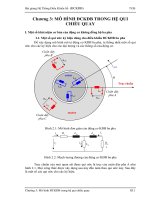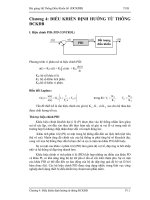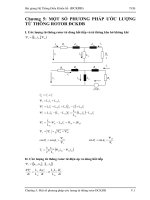Bài Giảng Hệ Thống ô tô
Bạn đang xem bản rút gọn của tài liệu. Xem và tải ngay bản đầy đủ của tài liệu tại đây (1.8 MB, 39 trang )
by
Russell Krick
Publisher
The Goodheart-Willcox Co., Inc.
Tinley Park, Illinois
© Goodheart-Willcox Co., Inc.
Permission granted to reproduce for educational use only
© Goodheart-Willcox Co., Inc.
Permission granted to reproduce for educational use only
Battery principles
Battery functions
Battery construction
Wet- and dry-charged batteries
Maintenance-free battery
Battery ratings
Battery temperature and efficiency
© Goodheart-Willcox Co., Inc.
Permission granted to reproduce for educational use only
An automotive battery is an
electrochemical device
It produces and stores direct current
electricity
© Goodheart-Willcox Co., Inc.
Permission granted to reproduce for educational use only
Battery Parts
© Goodheart-Willcox Co., Inc.
Permission granted to reproduce for educational use only
Discharging
Changes chemical energy into
electrical energy
Stored energy is released
© Goodheart-Willcox Co., Inc.
Permission granted to reproduce for educational use only
Charging
Electrical energy is converted to
chemical energy
Energy is stored until needed
© Goodheart-Willcox Co., Inc.
Permission granted to reproduce for educational use only
Battery Cycling
Repeated charging and discharging
Deep cycling
going from a very low charge to full
charge
can shorten service life
© Goodheart-Willcox Co., Inc.
Permission granted to reproduce for educational use only
Basic Battery Cell
Contents:
negative plate
positive plate
container
electrolyte (battery acid)
When a load is connected to the cell,
current will flow through the load
© Goodheart-Willcox Co., Inc.
Permission granted to reproduce for educational use only
Lead-Acid Battery Cell
Electrolyte causes
a chemical reaction
between the plates,
producing 2.1 volts
© Goodheart-Willcox Co., Inc.
Permission granted to reproduce for educational use only
Cell Action
(Charging)
Alternator causes free electrons to be
deposited on the negative (–) plate
This causes the plates to have a
difference in potential (voltage)
© Goodheart-Willcox Co., Inc.
Permission granted to reproduce for educational use only
Cell Action
(Discharging)
Load is connected across the terminals
Current flows through the load to
equalize the difference in charges on
the plates
Excess electrons (current) move from
the negative plate through the load to
the positive plate
© Goodheart-Willcox Co., Inc.
Permission granted to reproduce for educational use only
Battery Cycling
© Goodheart-Willcox Co., Inc.
Permission granted to reproduce for educational use only
Operate the starter, ignition, and fuel
injection during cranking
Supply electrical power when the
engine is not running
Supply electrical power when current
demands exceed alternator output
Act as a capacitor (stabilize voltage)
Store energy for extended periods
© Goodheart-Willcox Co., Inc.
Permission granted to reproduce for educational use only
Batteries must be built to withstand
severe conditions:
severe vibration
extreme temperatures
corrosive chemicals
high current discharge
prolonged periods without use
© Goodheart-Willcox Co., Inc.
Permission granted to reproduce for educational use only
Battery Element
Battery plates
grid coated with porous lead
several in each cell
Lead strap
one connects several negative plates
another connects several positive plates
Separators
insulating material between plates that
keep them from touching each other
© Goodheart-Willcox Co., Inc.
Permission granted to reproduce for educational use only
Battery Element
Most automotive
batteries have
six elements
© Goodheart-Willcox Co., Inc.
Permission granted to reproduce for educational use only
Case, Cover, and Caps
Battery case
high-quality plastic, holds elements and
electrolyte
Battery cover
bonded to the top of the case
seals the top
Battery caps
keep electrolyte from splashing out
serve as spark arrestors
© Goodheart-Willcox Co., Inc.
Permission granted to reproduce for educational use only
Case, Cover, and Caps
Case holds the
elements and
electrolyte
© Goodheart-Willcox Co., Inc.
Permission granted to reproduce for educational use only
Electrolyte
Mixture of sulfuric acid and distilled
water
Poured into each cell until plates are
covered
Warning: electrolyte causes serious
burns or blindness if it comes in
contact with your skin or eyes!
© Goodheart-Willcox Co., Inc.
Permission granted to reproduce for educational use only
Electrolyte
Electrolyte
should just
touch the split
ring in the top
of the case
© Goodheart-Willcox Co., Inc.
Permission granted to reproduce for educational use only
Charge Indicator
Changes color to
show the general
state of charge of
the battery
© Goodheart-Willcox Co., Inc.
Permission granted to reproduce for educational use only
Battery Terminals
Means of
connecting the
battery to the
vehicle’s electrical
system
© Goodheart-Willcox Co., Inc.
Permission granted to reproduce for educational use only
Battery Voltage
Open circuit cell voltage is 2.1 volts
Cells are connected in series
Battery voltage depends on the number
of cells
A 12-volt battery has 6 cells and an
open circuit voltage 12.6 volts
A 6-volt battery has 3 cells and an open
circuit voltage 6.3 volts
© Goodheart-Willcox Co., Inc.
Permission granted to reproduce for educational use only
Battery Voltage
© Goodheart-Willcox Co., Inc.
Permission granted to reproduce for educational use only
